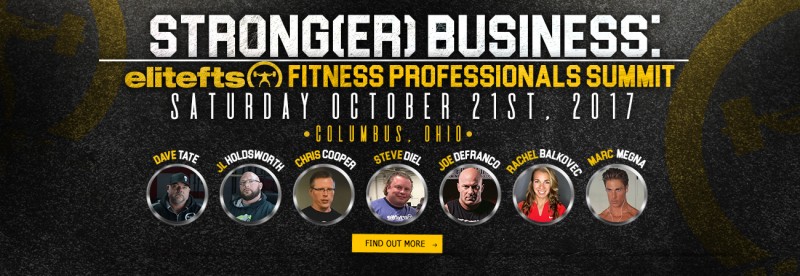
The topic of this article will be a focal point of Chris Cooper's presentation at the elitefts Fitness Professional Summit, Saturday, October 21, 2017. Designed to educate and assist business professionals in the fitness industry, this event will include presentations from other enterprise experts and established leaders such as Dave Tate, Joe DeFranco, Steve Diel, Rachel Balkovec, Marc Megna, and JL Holdsworth. For more information or to reserve your spot, visit the event detail and product page.
For our parents' generation, a salaried job meant stability. That was their top priority: predictable medium-to-high income for as long as possible — and I can't blame them. But in today's economy of opportunity, a salaried position in a gym is really a ceiling. For a good staff member, a salary can just get in the way of a great career. I'll explore the rationale behind this idea at the Strong(er) Business Summit in October, but for now, in this article, I will share the method we use to create opportunities for coaches in gyms around the world.
RECENT: The Goal Review Session
First, the basics: Your gym is more than a location. It's a platform for delivering fitness. Exercise programs can be delivered through personal training, semi-personal training, small group training, or large group training. Groups can deliver general fitness (like we do in our CrossFit groups) or specific fitness (like a "Couch to 5K" beginners' running group). They can run forever or for six-week blocks.
And fitness encompasses more than exercise. Your platform creates opportunities to help your clients in nutrition, mobility, mindset, job performance, cognition, relaxation, and more — but you can't deliver all of these services yourself.
Intrapreneurship means taking control of a big idea but staying under the safe umbrella of an established business. Many coaches think they want to be gym owners. Most of them don't; they just want to feel as if they have unending opportunity. And—though many don't realize it—they need some limitations to keep them on the path forward. This is where you, the gym owner, come in.
You Provide
- Physical Space
- Access to Equipment
- Payment Gateway
- Booking and Billing Software
- Online Platform
- Social Platform
- Access to Clients
- Insurance
- Credit Card Processing Fees
- Shield from Risk (they don't have to sign a lease or take out a loan)
- Opportunity
...and 44.4% of the gross revenue generated by the new program.
They Provide
- Expertise
- Time
- Programming (maybe)
This is Intrapreneurship: The opportunity to add a "building block" to your platform.
Let's walk through an example. If a coach specializes in weightlifting, she can run an eight-week program to help your clients improve their snatch. You'll charge $199. She'll keep 44.4% of that rate for each client. You'll cap the class at 12 students, and run it twice per week (16 total sessions.) She'll make $66.33 per hour coaching something she loves (total of $1061.33 if she coaches all the sessions).
There are many best practices associated with Intrapreneurship opportunities, and I'll lay those out in Columbus. But for today, look at your staff. Who wants to make a career in fitness (or a better one)? What's their passion? How can you lead them to fulfilling that dream?
Chris Cooper is the author of Two-Brain Business, Two-Brain 2.0 and Help First. A former powerlifter, Cooper opened Catalyst Fitness in 2005 after a decade in the fitness industry. The gym almost bankrupted him. When he realized that being a good coach didn’t make him a good business owner, he found a mentor and began his REAL education. He now owns two gyms (and three other companies, as well as a few buildings) in Sault Ste. Marie, Ontario. Since 2010, Cooper has published over 1000 free blog posts. His new site is twobrainbusiness.com, and his podcast is TwoBrainRadio.










